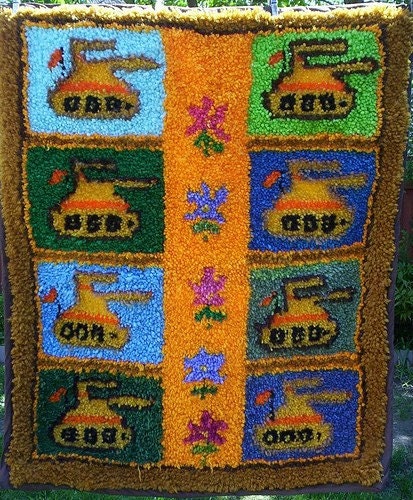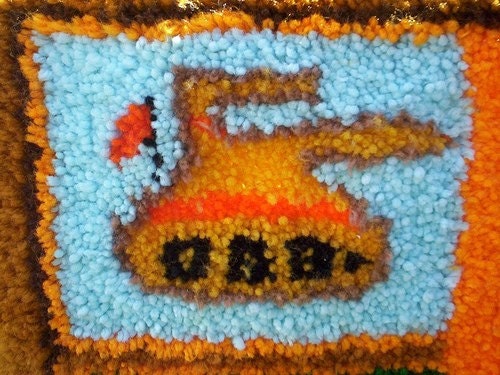Christina Ward has made this original design hooked war rug and posted it on her Etsy page


The rug above is notable for its Latif Chel minor borders combined with the more urban, Mashad-like, main border and pictorial rendering.
The rug below is silk on silk, and it is notable for the rendering of the purple mountain in the background, but particularly for the depictions of tigers where we usually see lions. Also notable is the bald eagle.
Please contact us for acquisition information. Also, for more information about pictorial rugs, please consider Kevin Sudeith’s book about pictorial rugs.
The folks at City Lore have posted an exhibition web site for the Weavings of War: Fabrics of Memory exhibition. Nice design. Tank slider is a nice touch.

The Globe and Mail is running a story today about Ritchies’ sale of war rugs (previous post). The story focuses on World Trade Center rugs. Without understanding the context of World Trade Center rugs it is easy to mistake their intent.
It is important to remember that during the 1990’s Turkmen weavers were ethnically cleansed from northern Afghanistan by the Taliban. These persecuted Turkmen sought the uncomfortable refuge of Pakistan’s refugee camps. In the camps, these Turkmen wove, amongst other things, Soviet Exodus Rugs of several styles. Soviet Exodus grew out of Turkmen map rugs from the 1980’s rugs. Soviet Exodus rugs in turn were a direct antecedent to the small Tora Bora rugs , like these, these, and these, as well as World Trade Center rugs like these , and these. (Please see photos below for more clear pictorial demonstration.)
In short, the Turkmen weavers (who make WTC rugs) were sincerely happy to get out of Pakistan and return to their traditional homes (since the Bolshevik revolution – story for another post) in Afghanistan. They understood that their return would not have bee possible without the American invasion provoked by the September 11 attacks. World Trade Center rugs convey the unity between the Afghan Turkmen and America / ISAF to forge the new Afghanistan.
During the intervening years since 2001, the Turkmen region in northern Afghanistan is one particularly successful, bright, and under reported, region in America’s two wars. The Turkmen region between Kunduz and Aqcha (where WTC rugs originate) is (by Afghan standards) secure, peaceful, and prosperous. Unlike other weaving areas of Afghanistan where the war is currently roiling, the Turkmen region is peaceful and secure. This region has poached much of the carpet production from Taliban infested western Pakistan. There is significant infrastructure development particularly in transportation and telephony. The Turkmen area in Northern Afghanistan is a significant success for America/ISAF in Afghanistan.
The safety and security of this region is illustrated by an Afghan friend of mine who was traveling the road from Herat to Kunduz recently. As he approached Aqcha he was stopped by soldiers at a roadblock. “This road you couldn’t have crossed with a tank 10 years ago”. My friend was traveling in a small car whose trunk was literally loaded with bales of cash for purchasing carpets. The soldiers searched his car, found the obvious load of cash, and bid him on his way unmolested.
Here is a pictorial history of Turkmen map rugs from the 1980’s through the present.
1980’s:
Turkmen weavers back in Afghanistan after 2001:
Tora Bora Rugs:
And, three styles of World Trade Center Rugs (2002 examples)
Max Allen has written with a link to an auction benefiting the Textile Museum of Canada featuring exclusively war rugs. The action is being held by Ritchies.
A significant historic building in Kabul is the Mosque of the King of Two Swords [lots 41, 43, 44]. Brandishing a sword in each hand, the legendary Islamic warrior Layth bin Qays bin Abbas, whose grandfather was an uncle of the prophet Muhammad, led a battle against the infidel Hindu forces (hence the elephants in lot 43) who were protecting Kabul’s holiest Hindu temple. The Mosque of the King of Two Swords today occupies the site of the Hindu temple. Originally dedicated in 1544, restored by King Amanullah’s mother in 1920, largely destroyed in the 1980s during the post-Soviet civil war, it has once again been beautifully reconstructed.
Ritchies database is a very nice complement to the The Textile Museum of Canada’s database.

Above and below are Al Kwaja Rugs.
Here’s the warrug.com index of Al Kwaja rugs.


Above is a 1980’s , Rows of Weapons Design, like rug #915

My book features two rugs of the design above, one with the Farsi words for Amu Daria and peacock, and one featuring the Kaaba.

The rug above is the clearest example of this image. It is also the best clue yet as to what these rugs are depicting?
If you are interested in bidding, register now.
I received an excellent question from our contact form recently about the lack of Red Rugs available for purchase on warrug.com lately. Below is was my response:
Your question about Red Rugs is a good one. Red Rugs were woven by refugees, primarily Turkmen, in Pakistan during the 1990’s. Since the US forced the Taliban from power in 2001 Turkmen refugees have been returning en masse to their traditional homes in Afghanistan, largely because ISAF offers them sufficient protection from the Taliban ethnic cleansing which drove many families to Pakistan during the 1990’s.
The effects of the Turkmen weavers returning to their homes in Afghanistan is, primarily, two fold. First, as refugees, if one was an engineer, one wove carpets. If one was a doctor, one wove carpets. Now the doctors and engineers are returning to their professions, so there are less weavers available to weave any type of rug. Secondly, many Turkmen weavers who wove Red Rugs in Pakistan are now weaving traditional designs or new variations of traditional designs (Khul Mohammadi mostly).
Much of the Pakistan production has moved to Afghanistan (Khul Mohammadi, Kazak, Vegetable Dye ‘Peshawar’) with the returning weavers, but not Red Rugs. I have not seen any Red Rugs produced in Afghanistan since 2001. In short, there is no more supply of Red Rugs. Occasionally I find a few Red Rugs and I post them, but they are scarce.
Lastly, this elimination of a design is not unique to Red Rugs, yet it continues to surprise me. Almost every war rug “pattern” has its moment of production, which then fades or stops. What is freely available one year, is totally unavailable the next year. Soviet Exodus rugs are one example and WTC rugs to a lesser degree.
Again, thank you for your question. Please write back if you have any further questions or comments.
British paratroopers Private Danny Berk, right, and Corporal Scott Evens move through a hole blown in a compound wall by a grenade, Saturday Aug. 31, 2008, while protecting a convoy. The convoy consisted of over 100 vehicles in total, some carrying equipment and a new turbine for the power station at the Kajaki Dam. It passed through Taliban positions which were hit with artillery, mortars, Apache Attack helicopters firing rockets and Hellfire missiles, and fast jets dropping precision guided bombs, which resulted in an estimated 250 Taliban casualties. (AP Photo/Sgt. Anthony Boocock, MOD ho)